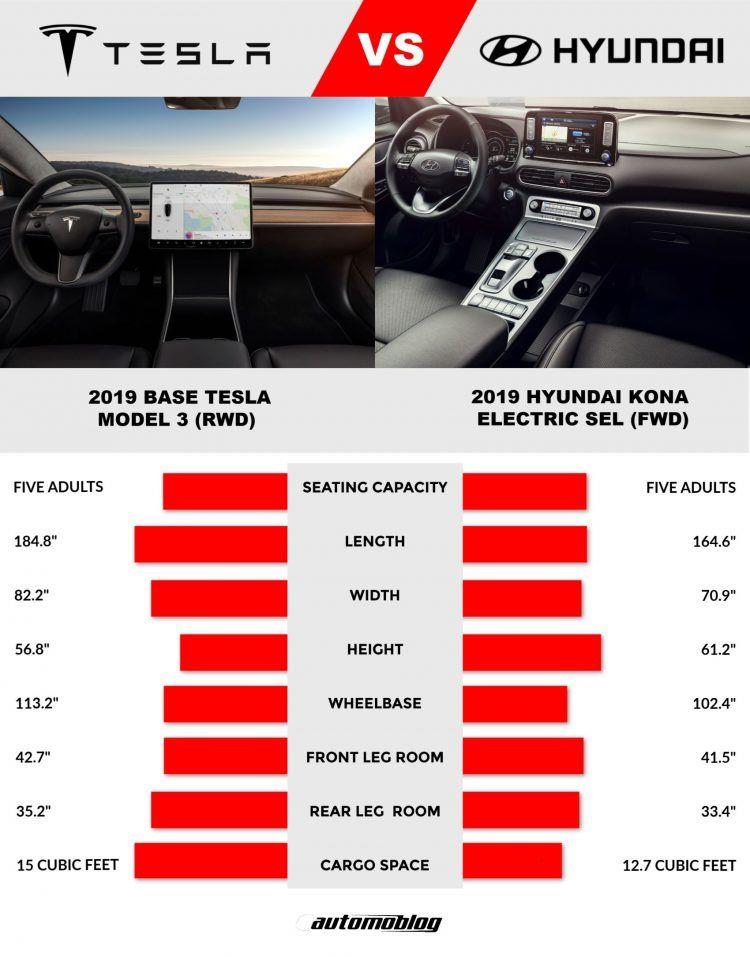Electric cars Tesla Model 3 and Hyundai Kona Electric are very different and even poorly comparable. However, these are the models that break down the barriers to understanding the functions of the car in modern human life. Both machines are available, but are very expensive. And both options are worth considering if you want to buy an electric car.
Tesla Model 3 and Hyundai Kona Electric in virtual battle
First of all, let's explain a little about the goals, what is compared with what. Why is it even about comparing the Tesla Model 3 with the Hyundai Kona Electric? The Tesla Model 3 is a sport sedan with low ground clearance, while the electrified version of the Hyundai Kona is a small crossover. In fact, it is not the classes of cars that are compared, but, in principle, affordable electric cars. These two models are commercially available and cost commensurate money.
Let's also note the expert fact that before Tesla could introduce the base Model 3, Hyundai created what could possibly be the best mass-market EV. With prices starting at $36,450 (excluding taxes), these machines are relatively affordable and not cheap.
Compare the main characteristics
The Tesla Model 3 currently comes in three flavors. The base standard range starts at $39,500 (excluding taxes and deductions) and can go 240 miles on batteries. There is a more powerful model rated for 310 miles. Its cost starts at $49,500 (excluding taxes and benefits). The extended Performance version offers the same 310 miles, but accelerates faster and has better agility. It costs from 59,500 dollars. These prices do not include shipping and other fees. Tesla has a habit of changing the prices of its cars, and this often happens suddenly. It has happened before and will happen again.
What are we comparing?
For this virtual showdown, we're pitting the base Tesla Model 3 Standard Range Plus against the base Hyundai Kona Electric. Interestingly, the Kona EV is available in three trim levels (SEL, Limited, and Ultimate), but they all feature the same battery and electric motor. The Hyundai Kona Electric SEL has a starting price of $36,450 (excluding tax credits and user fees).

Tesla Model 3 and the gold standard
Production and quality issues aside, the Tesla Model 3 remains the gold standard for relatively affordable EVs. In fact, it is seen by many as the luxury car of the new age. With prices hovering below 40,000 $, this is seriously attracting the attention of the mass buyer. They seem to be willing to pay any figure (and deal with long wait times) to try out the Tesla. However, if you're on a budget but want to ditch the traditional gas-powered car, you're not alone.
Tesla is already feeling the competition in the market. And what's interesting is the significant price cuts for the Model S and Model X. Some say Tesla is desperately trying to keep the attention of buyers to ensure steady demand. And demand at least in the short term. According to experts, the company is fulfilling the last tasks of its mission: producing a great, high-tech, long-range and exciting electric car at the lowest price.
Despite the abundant criticism, the fact is indisputable. Tesla started the real EV revolution and they deserve credit for that.
Extended versions
For some buyers, paying more than thirty thousand dollars for a new car is not expensive. But for those who know what they charge, the price is nothing compared to the fuel economy and performance of the base Model 3. True to Elon Musk's credo of creating an electric car that is fun to drive, even the base Model 3 Tesla will fulfill the desires of the most demanding buyers. .
The base model Tesla 3 (Standard Range Plus) has one electric motor and a single-speed automatic for turning the rear wheels. It can accelerate from zero to 60 mph in 5.3 seconds. Estimated range is 240 miles or 386 kilometers. Prices start at $39,500, but you'll end up paying around $35,750 after tax credits.

Minimalist yet modern interior
What do you dislike about the Tesla Model 3's minimalist interior? The instrument panel is devoid of conventional buttons and switches. All you get is a 15-inch central touchscreen to control various vehicle settings and that's it. It's pleasantly high-tech yet incredibly easy to use.
The glass roof allows natural light into the interior. Yes, the base Tesla 3 comes with a tinted glass roof. There are two scroll buttons on the steering wheel that perform different functions depending on the selected settings. The Model 3 does not have the usual air vents, keeping the dashboard design spotlessly clean. The interior feels completely different, yet familiar at the same time. Moreover, the Tesla Model 3 is no more difficult to use than a regular smartphone.
Oddly enough, the introduction of the base Tesla 3 did not come without compromises. The interior is a bit cheap, the seats are upholstered in fabric, and there are manual adjustments. It's okay if you are not so sophisticated in technology and minimalist design. But the completely black interior is not to everyone's liking. However, everyone likes the standard 18-inch wheels.

Excellent practicality
The Tesla Model 3 offers the interior volume of a midsize luxury sedan. It can accommodate five people. The car offers 15 cubic feet of cargo space in the rear, with plenty of space under the front trunk. If you need to carry long items, just fold down the rear seats for more space. Tesla managed to choose the right frames to make the interior comfortable and casual.
With the standard 3 range model, you still get an impressive set of technologies. This includes smart navigation, Bluetooth, and a basic audio system. Driver assistance systems are also standard. These are lane departure warning, forward collision warning, blind spot monitoring and collision avoidance. Advanced Autopilot is also available and includes adaptive cruise control, self-parking. Lane keeping assist and automatic lane change are also provided.
Tesla Model 3 Charging Options
The Tesla Model 3 comes with a standard 32 amp charger. Long haul models get a 40 amp charger. Also included is a 20-foot mobile connector and plug, along with a 120-volt NEMA 5-15 adapter; NEMA 5-15.
Charging with a mobile connector provides approximately three to five miles of movement. Tesla has a variety of other adapters that require more mph charging time.
What makes the Tesla Model 3 better than other electric vehicles is the ability to quickly charge or recharge. The Model 3 provides a 170 mile car charge in 30 minutes. This means you can get back on the road faster than other electric vehicles. The system is also designed to protect the buyer from loss of charge between destinations. This fear is one of the biggest concerns when buying an electric car.

Hyundai Kona Electric: the evolution of affordable electric vehicles
This is true. The Hyundai Kona Electric not only has a more gorgeous performance of the Kona crossover, but also offers a very interesting evolution of features. Even before the base model Tesla 3 Hyundai Kona Electric hit showrooms, it was already on the list of the best and most affordable electric vehicles. Not because it's a crossover or small SUV (which makes it desirable in today's market). Kona Electric helps you make amazing choices to move away from owning a gas car.
I have to admit that the Hyundai Kona Electric isn't as fast or as cool as the Tesla Model 3. But at this point in an EV, speed or toughness isn't as important. In order to succeed in the electric vehicle market, you need to adhere to three main principles:
- driving range on one charge;
- easy charging;
- affordable price.
All other details are just a bonus, often conditionally claimed.
With that said, the Hyundai Kona Electric holds up very well to the competition.

Superior Performance
Hyundai Kona Electric is powered by a single 201 hp permanent magnet AC synchronous motor. and 290 lb-ft of torque. That's enough to take the Kona Electric from zero to 60 mph in 7.6 seconds. That's slower than the base Tesla 3. But not bad when you think about it, since the Hyundai Kona Electric is more of a crossover than a sedan. However, speed is only a small part of the equation.
What really makes the Hyundai Kona a very pleasant choice is the 64kWh lithium-ion battery pack. Which corresponds to the EPA claimed mileage of 258 miles. The model outperforms the Jaguar I-Pace (234 miles) and Chevrolet Bolt EV (238 miles), and more importantly, it outperforms the base Tesla 3!
In many ways, the Tesla Model 3 is clearly superior to the Hyundai. But Kona Electric offers a wider range of models and add-ons than a comparable-priced alternative.
Sporty driving feel
Although the Hyundai Kona Electric has a less powerful electric motor than the Tesla Model 3, it has a smart design that gives a sporty driving experience. The battery pack shifts the center of gravity 3.6 inches lower to the ground than a regular gasoline-powered Kona. This improves the Kona Electric's handling characteristics, especially in Sport mode.
Hyundai Kona Electric is also equipped with regenerative braking, which means that the batteries are being charged at this time. Behind the wheel are paddles that adjust regeneration settings. The machine has a single pedal driving function and it is very comfortable.

Wins on practicality
Hyundai Kona Electric is a five-seater crossover. However, since it's based on the petrol version of the Kona, it offers less cargo space than the Tesla Model 3. But since the Kona Electric is only 164.6 inches long, that's a comfortable fit too.
The Kona Electric's control panel doesn't feel quite as high-tech as the Tesla Model 3's minimalistic instrument panel. On the other hand, it's also convenient. If you want to familiarize yourself with the controls of the Hyundai Kona Electric, you may not look for it in the menu.
In truth, the interior of the Hyundai Kona Electric is no different from the petrol model, except for the lack of a gear lever. It has now been replaced with buttons to enable Park, Neutral, Reverse and Drive modes.
The Hyundai Kona Electric SEL is equipped with LED daytime running lights, a seven-inch touchscreen display and a seven-inch instrument cluster. There are also LED taillights, heated front seats, automatic climate control. Buyers will be pleased with options such as a leather steering wheel, Apple CarPlay and Android Auto, and 17-inch alloy wheels. That's all pretty good for a base price of $36,450 (excluding tax credits), right?

Hyundai Kona and its charging
Hyundai Kona Electric is equipped with a built-in 7.2 kW AC charger. It recharges the 64 kWh battery pack in about 10.5 hours using a 240 volt outlet. The car also supports fast charging with the Hyundai SAE Combined Charging System (CCS). It can quickly charge the battery in just 45 minutes. However, the CCS system is not as widespread as the Tesla network.
Tesla Model 3 vs. Hyundai Kona Electric. What are the conclusions?
It is very difficult to draw a definitive conclusion in this case. While it's impossible not to appreciate the qualities of the Tesla Model 3, it's hard to ignore the Hyundai Kona Electric's value proposition. As for the base Tesla, it must have an upgraded battery pack to match or exceed the Hyundai Kona Electric range. Unfortunately, this is not so.
If you want to use the Tesla Model 3 with at least 300 miles of range, you need to opt for the long range model, which starts at $49,500 (excluding tax credits). This price tag is already out of reach for many.
Experts don't dispute the fact that the Tesla Model 3 is a superior vehicle, but they're not wrong about the Hyundai Kona Electric's appeal.
Photo Source: Tesla Motors, Hyundai Motor America.






